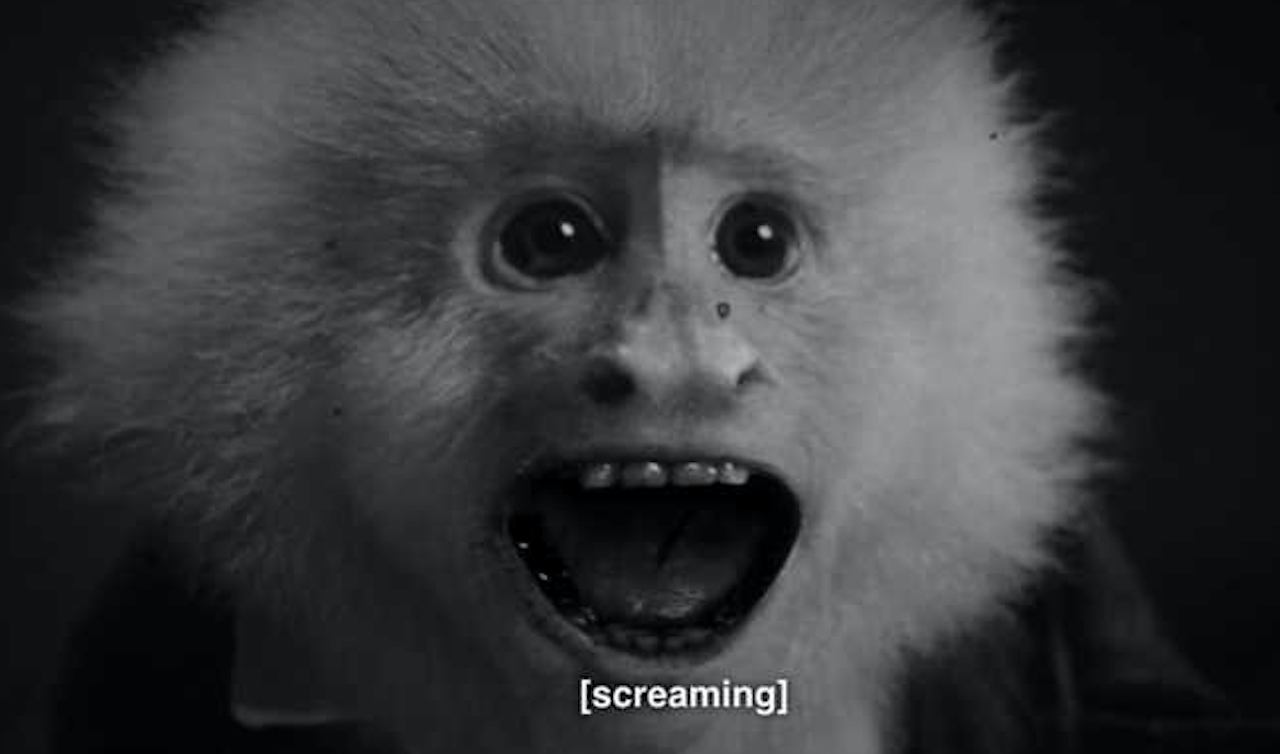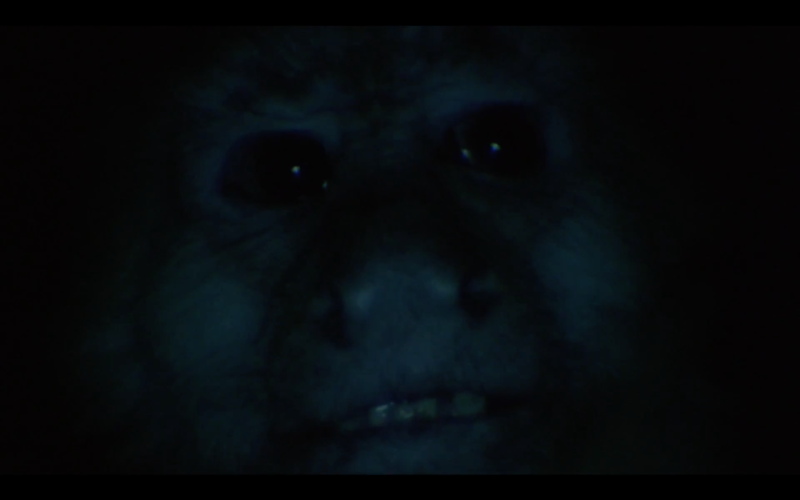
David Lynch’s seldom-seen short, “How Now Brown Cow?” begins with an industrial din of clanks and genitalia-tightening screeches punctuated by the occasional shriek of an unseen bovine. The entire screen fills with smoke that appears to be exuded by an antique radio with no dial, positioned on a Formica table beside a (gradually visible) phantom in a kind of modified welder’s helmet that renders the figure featureless. He is seated in a lawn chair, dressed in a designer Thom Browne suit and a butcher’s apron that drips with a viscous black liquid. From behind the camera, a guest clomps into focus: a retro-sexy woman aloft on full-body crutches that give a great clatter as she finally finds a seat before the butcher.
The butcher finally speaks in a halting, cornfed Jimmy Stewart accent, “Have you cast a shadow lately?”
“What… is… this?” the woman stutters, “The… farmer… in… the… dell?”
“Old McDonald had a farm,” says the butcher.
“He… fell… into… his… own… thresher,” the woman replies.
A conveyor belt next to the butcher stirs to life and carries a miniature, poorly-CGI’d cow to the butcher. Once sliced, the cow deflates with a fartsome alarum. The short ends with the butcher removing his helmet to reveal Lynch himself, his famously curvilinear hairdo somehow intact, and we cut to black while “Duke of Earl” as sung by Johnny Casino and the Gamblers plays over the credits for no reason. Where’s Angelo Badalamenti when you need him?
I’m just kidding. “How Now Brown Cow?” isn’t a real David Lynch movie, but it might as well be, considering how interchangeable and indifferent the output of the once-untouchable maestro behind Blue Velvet and Twin Peaks has become. There is only one way to be normal—that’s why it’s called normal—but a million ways to be weird, and in the course of his long career, David Lynch has developed a style, or rather a set of rules, characterized by violence, menace, and non-sequitur, all firmly positioned under the banner of a weirdness that regularly frustrates the same urge toward interpretation that it stimulates. Lynch can lay claim to a surprisingly broad appeal that makes me think of Thomas Pynchon’s famous observation that “Every weirdo in the world is on my wavelength.” Lynch could say the same. But what’s weird without unconformity, without deviation, joy, and upset? Now more product than director, Lynch’s tropes are immediately recognizable: physical deformity, buzzing electricity, extremely hot women, rockabilly tunes, and twisted Americana, not to mention having done for chessboard-pattern foyers and red curtains what Tim Burton did for striped socks. Oh, and everyone smokes. If hipsters printed their own currency, Lynch would be on the twenty.

In 1962, the film critic Manny Farber divided films into elephant art (bloated) and termite art (devious), but a more modern calibration might be between piss (immediate) and shits (takes some work). David Lynch takes loooong shits, the kind you want to show off to your friends. Neither fully “art” films nor mainstream blockbusters, Lynch’s movies act as a transit between the two. When I arrived in college, I was suspicious of anything that aspired to art; baffled by the moral equivalence of M, straight-up intimidated by Bergman, certain that Godard was scoffing at me. I didn’t have the vernacular to appreciate fine cinema. But I was a maniac for Lynch, whose films you pretty much had to love to be friends with me. Leaning into his highly referential aesthetic, with their enthusiasm for quoting classic Hollywood and cinema verite alike, I found myself gradually more comfortable. The trick, I realized, was to surrender. Doing right by the auteur means eschewing the easy guardrails of convention because that’s where art is at.
Lynch’s movies are at their best a gateway between dreams and reality; but after a while, only hearing about someone else’s dreams gets boring and you hunger for some substance. And that’s what Lynch has been lacking in the almost fifteen years since he has made a real movie. What’s he been doing in the interim? Well, he’s started a line of organic coffee, made ads for Dior, appeared on a Family Guy spin-off and guest-starred on Louie, been awarded the key to the city of Bydgoszcz, designed a Duran Duran concert, directed a music video for Nine Inch Nails, curated the Festival of Disruption (featuring tepid sets from the likes of Animal Collective and Flying Lotus), released three warbling studio albums, published a collection of tastefully photographed butt cracks called Nudes, and become the poster boy for Transcendental Meditation, which he learned from Maharishi Mahesh Yogi during a “Millionaire’s Enlightenment Course,” the entry fee of which will set you back one-million dollars.
Lynch’s long descent from artist to brand has been expedited by the fact that he has no casual fans, only devotees for whom he can do no wrong. If you’ve seen one of his movies, you’ve probably seen them all multiple times (there’s only ten of the things, after all, and one of them is Dune) and chased down every scrap of celluloid the man ever touched, whether it’s the deleted scene from Twin Peaks: Fire Walk With Me where David Bowie explodes and a bellboy shits his pants or arcana like Lynch’s student films “Six Men Getting Sick (Six Times)” or “The Grandmother.” The result is a kind of smug, uncritical echo chamber high on style but bereft of ideas (this is the same Lynch who once referred to ideas, beautifully, as “the best thing going.”) But at the moment, “Lynchian” is no longer representative of the quality David Foster Wallace called “a particular kind of irony where the very macabre and the very mundane combine in such a way as to reveal the former’s perpetual containment within the latter.” Instead, it signals a knee-jerk, reliably oddball goofiness cut with noir-ish cool that looks an awful lot like complacency, or even self-parody, and which relies on Lynch’s cult of personality for its clear-as-mud cache and winds up treating his fans like a pod of trained dolphins in the bargain. Of course, it’s hardly fair to blame filmmakers for getting older. In Les Blank’s Werner Herzog Eats His Shoe, the legendary Herzog declares a “holy war” against commercials and light entertainments. We have lost that war, and now Herzog rhapsodizes over Baby Yoda and Lynch has abandoned his pedigree as America’s hardest-working freakazoid in favor of whooshy dilettantism.
What else are we to make of “What Did Jack Do?” This seventeen-minute film, which premiered on Netflix sans fanfare, consists of David Lynch, playing a detective or something, chain smoking and talking to a capuchin monkey for the duration (this one’s real, I promise). Met in a train station, Lynch questions the monkey—billed as “Jack Cruz” as himself—regarding a murder that has something to do with Jack’s forbidden love affair with a hen named Toototabon, though most of the film is pretty stream-of-consciousness: “Well, there is no Santa Claus,” says Lynch and Jack, whose mouth is superimposed and animated via the cheap Syncro-Vox technique famous from Clutch Cargo and early Conan O’Brien, replies, “I won’t be here for Christmas.” “There’s an elephant in the room. I’d like you to start talking turkey,” Lynch says, and “I know why the chicken crossed the road,” and “Are you now or have you been a card-carrying member of the Communist Party?” and so on. It’s a pretty dismal state of things when the new David Lynch movie prompts bathos in place of wonder. The monkey, which sounds an awful lot like Lynch himself, isn’t even my favorite Lynchian primate—that would be the one from Twin Peaks: Fire Walk With Me that appears toward the end of the film and says, “Judy,” which is just as random, but somehow feels right. This third-eye for unexpected resonance was ever Lynch’s forte. Why does a man carry a red pipe through the background in Wild At Heart? What is it about Roy Orbison that so completely fits the mood of Blue Velvet? What’s with all the creamed corn (“garmonbozia,” we’re told) in Twin Peaks? There was never going to be an answer to any of these flourishes, but we trusted that Lynch on some level knew what he was doing and the open-ended nature of his narratives meant that they seldom dated or were saddled with the unsatisfactory slapdash finales or extraneous sequels that pervade most TV and film respectively.

But now it may be time to ask the question that Lynch has evaded so eloquently throughout his career: Just what is the point of all this? Well, in the case of Jack, it turns out it’s to sell you things: the label Sacred Bones has just released a single of Jack singing a song entitled “True Love’s Flame” with the B-side “Dancin’ in the World of Love.” I’m not prepared to say that 2017’s revival of Twin Peaks wasn’t the television event of the decade, but it also telegraphed Lynch’s disinterest in pleasing his audience, overstuffed with performances by trendy bands like Chromatics and Au Revoir Simone, cluttered with subplots that go nowhere, and promoting Lynch’s FBI character Gordon Cole to a starring role. The plot seldom got in the way of the story, with mixed results: it was embarrassingly chauvinist and unconcerned with returning to the original series’ coffee-and-cherry-pie bonhomie, nor in resolving the myriad love triangles that energized the first two seasons, but there was also an air of palpable mystery, intrigues galore, Harry Dean Stanton, and the fabled eighth episode, easily the most intense hour of television in modern history (what it wasn’t was fun, unless your idea of a good time is watching futzed-with footage of the atomic bomb in New Mexico set to “Threnody to the Victims of Hiroshima” by Krzysztof Pendereki is your idea of a romp.) What did any of this have to do with the murder of Laura Palmer, the fate of Special Agent Dale Cooper, and the various cliffhangers left over from 1991? Well, once again, you had to buy something for the full story, co-writer Mark Frost’s The Secret History of Twin Peaks and Twin Peaks: The Final Dossier.
David Lynch is unquestioningly a genius, but unfortunately someone told him. I’m all for an artist amusing themself at the expense of their audience, but there’s something masochistic about the blank check for bad behavior that we’ve given Lynch, who more often than not rewards his fan base’s willingness to follow him through the dark side of the unconscious with P.T Barnum hokum. David Foster Wallace is correct to observe that it’s the density of juxtaposition that produces Lynch’s best work as he combines elements not obviously of a piece: corn muffin goodness and sexual perversion in Blue Velvet, true love and hideous violence in Wild at Heart, Hollywood glitz and nightmares in Mulholland Drive, and David Lynch and G-rated Disney in The Straight Story. But when Lynch’s zonked-out style operates in a vacuum without some opposite to push against, it hangs limp.
Part of what’s missing is the old sense of play. In Wild at Heart, he allowed a recurring Wizard of Oz motif, absent from Barry Gifford’s original novel, to creep into the story of the star-crossed lovers Sailor Ripley and Lula Pace Fortune (Nicholas Cage and Lynch’s muse Laura Dern) and it somehow worked. Mullholland Drive was repurposed from an unsold television pilot which made it feel open-ended, pendulous, and rich with grisly portent. He was more than willing to incorporate happy accident—prop man Frank Silva cast as the Killer BOB after being caught on film in the Twin Peaks pilot, the extra in the autopsy room who mishears a line and replies “Jim,” actor Robert Loggia’s real-life rant after being passed over for Dennis Hopper in Blue Velvet written into Lost Highway as the gangster Mr. Eddy, and Michael J. Anderson’s talent for speaking backward informing the famous shot-in-reverse scenes in the Black Lodge. The present-day Lynch, by comparison, appears to be running on coffee fumes and maybe one of the Twin Peaks-themed cocktails you can buy at Lynch-centric concerts and fan-run events like the Fish in the Percolator (two parts whiskey rye, one part coffee liqueur).
That most applicable phrase to explain latter day Lynch, who now describes the weather from his office, draws a comic strip about a dog, and sings the praises of quinoa on his website, comes from Lynch’s old chum, Captain Beefheart himself, Don Van Vliet who once told an interviewer that “You don’t have to be Weird to be weird.” David Lynch seems to be committed to a sustained method act in the role of “David Lynch,” but we seem to have forgotten it’s not the self-mythologizing auteur, with his retinue of famous friends, giving obfuscating answers to straightforward questions about art, pretending unconcern with his fatuous late-career celebrity, and droning on about TM, that we actually love. It’s the movies, whose fragmentation and impenetrability seemed to speak to a fragmented, impenetrable world. Of course, funding for esoteric films that ensure the director final cut doesn’t grow on trees (and his movies have almost always depended on the overseas box office to make a profit, especially in France and Japan), but Lynch has clearly chosen Weird over weird. If he really had any passion left over for filmmaking, we would see less of him and more of everything else. Without another film project or foray into high strangeness, Lynch’s legacy will be a triumph of style over substance, a Band-Aid hastily plastered over the human soul. This isn’t just bad for Lynch, it’s bad for the future of filmmaking, as his heirs will cease to make films that trouble us in favor of films that flatter us. In other words: monkey see, monkey do.




